Once I had all three fins tacked on, it was time to make the internal, and external fillets. I decided not to use the same ad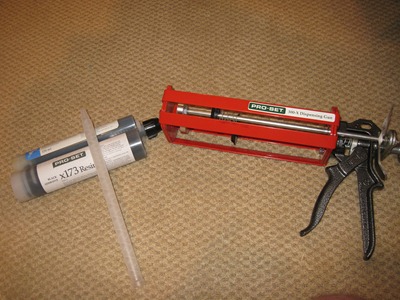 hesive epoxy I had used to tack on the fins, and build the motor tube. While I really like the E-120HP, once cured, it is almost impossible to sand. I’ve used it once before on external fillets, and when I went to sand them down, I wound up taking a lot of the fiberglass around the fillet, but not the fillet itself. Instead, I opted for Pro-Set x173 / 275. Pro-Set is owned by the Vaughn Brothers, the same parent company that West Systems is. West Systems is a very popular adhesive, and laminating resin used by others in hiigh power rocketry. The two main differences between Pro-Set, and West Systems is Pro-Set comes in a cartridge system for use in a big glue gun (and, I like glue guns!), and they offer specialty resins for the aerospace industry. X173 is a black adhesive aerospace resin with some interesting properties. First, it can handle extremely high temperatures – higher than JBWeld. Second, it has an extremely high tensile strength – well over 10,000 psi. It’s hardness (Shore D) is above one hundred when used with a medium or slow hardne
hesive epoxy I had used to tack on the fins, and build the motor tube. While I really like the E-120HP, once cured, it is almost impossible to sand. I’ve used it once before on external fillets, and when I went to sand them down, I wound up taking a lot of the fiberglass around the fillet, but not the fillet itself. Instead, I opted for Pro-Set x173 / 275. Pro-Set is owned by the Vaughn Brothers, the same parent company that West Systems is. West Systems is a very popular adhesive, and laminating resin used by others in hiigh power rocketry. The two main differences between Pro-Set, and West Systems is Pro-Set comes in a cartridge system for use in a big glue gun (and, I like glue guns!), and they offer specialty resins for the aerospace industry. X173 is a black adhesive aerospace resin with some interesting properties. First, it can handle extremely high temperatures – higher than JBWeld. Second, it has an extremely high tensile strength – well over 10,000 psi. It’s hardness (Shore D) is above one hundred when used with a medium or slow hardne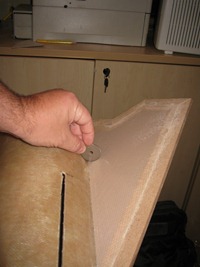 r, yet it can be wet sanded. I didn’t say it was easy to sand, certainly not like a traditional epoxy or laminating resin, but much better than hysol.
r, yet it can be wet sanded. I didn’t say it was easy to sand, certainly not like a traditional epoxy or laminating resin, but much better than hysol.
Since it is still difficult to shape and sand post cure, I spent a lot of time prepping for the fillet, and used a technique that generally creates baby-smooth fillets that don’t need a lot of work. I think I need to give Tim Lehr credit for process, as I think I first saw it from on a mongoose using proline epoxy, which is very similar to the x173 / 275 I am using. First, I take a washer and run it down the length of the aiframe, and fin, creating a very light scrape in the fiberglass where ithe metal’s edge touches the fin and airframe. I then measure the line, with a ruler and put down a few dashes along the line with a marker., ensuring each mark is measured accuratly. Once I have my guide lines down, I t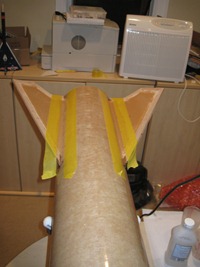 ake 1/2” airbrush masking tape and lay it down exactly on the marked guidline. The tape is now at the trailing edge of the fillet I am going to make, and willl ensure an even line once the epoxy has set. I should point out I’ve now coupled the upper and lower airframe together, to give me enough weight to secure the lower airframe to a PVC rocket holder. Since this have a very high set time, I need everything to be very secure for at least a day once complete.
ake 1/2” airbrush masking tape and lay it down exactly on the marked guidline. The tape is now at the trailing edge of the fillet I am going to make, and willl ensure an even line once the epoxy has set. I should point out I’ve now coupled the upper and lower airframe together, to give me enough weight to secure the lower airframe to a PVC rocket holder. Since this have a very high set time, I need everything to be very secure for at least a day once complete.
You would think I would just use that awesome mixing wand to put a nice even bead down, and be done. Unfortunately, experience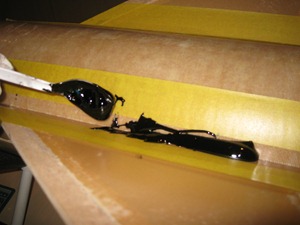 e has proven I don’t have the skills to make a good fillet with a gun and wand this big. I opt to fire the epoxy into a cup, and hand mix the epoxy the traditional way. Once mixed, I take a spoon, and fill the space between the masking tape. This stuff is really hard to control. It has a very high viscosity which makes it difficult to work with, but, of course, that’s what the tape is for. I then prepare a cup of isopropyl alcohol, lots o
e has proven I don’t have the skills to make a good fillet with a gun and wand this big. I opt to fire the epoxy into a cup, and hand mix the epoxy the traditional way. Once mixed, I take a spoon, and fill the space between the masking tape. This stuff is really hard to control. It has a very high viscosity which makes it difficult to work with, but, of course, that’s what the tape is for. I then prepare a cup of isopropyl alcohol, lots o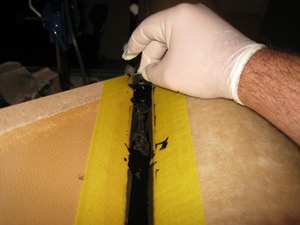 f paper towels, and a second cup to catch the excess epoxy.
f paper towels, and a second cup to catch the excess epoxy.
I take the washer, dip it in the alcohol cup, and take small pulls of the washer to even out the epoxy, eventually pulling the excess of the end of the fin into my second cup. Once it’s even, I redip the washer in Alcohol, and take one final pull slowly, and evenly from one end of the fin to the other. The end result should be
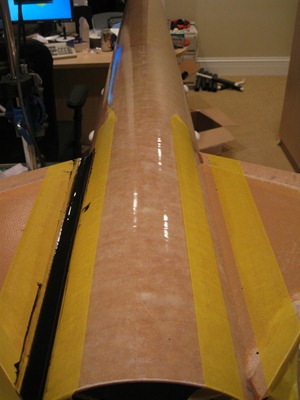
an
extremely smooth, almost glass-like fillet. I then take a tongue depressor, and create a taper on the leading and trailing edge of the fillet. On the leading edge, this will make it easier to do tip-to-tip lamination, while in the rear, it will even the height of the fillet (and lamination) to the boat tail which will be installed later. I repeat the same process on the second fillet. Once the external fillets are finished, I start work on the internal fillets. Frankly, the care and preperation I took on the external fillets all went out the window for the internal fillets. Nobody is going to see these, and they don’t need to be smoothed, as I don’t plan on laminating the inside. In fact, I plan on foaming the inside, so human eyes are never going to see these again. I did take some pictures, but upon review, I’m actually a little embarrassed how messy I was. Looks like my four year old had a field day in there. I wait about 90 minutes – enough time for the external fillets
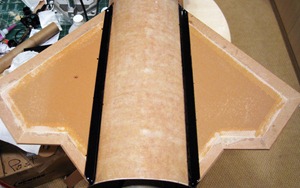
to start to set, but WAY before they are really cured, to pull the masking tape away, leaving a clean fillet line on each side. The picture to the left is actually 24 hours later, after the epoxy is cured. You can see the fillet still looks wet, it’s so glass-like smooth. Once done, I repeat this process three more times, ensuring both sides of each fin have exactly the same fillets,while the inside looks like a barrel of monkeys had a poo fight. I then wait an extra day for good measure before I start foaming the in tabs.
Foam can be both fun, and frightening. Its really cool to watch foam set and expand, yet at the same time, if you miscalculate how much foam you need, you can have a huge mess on your hands. In my case, too little foam in the first pass, and I would find myself having to deal with three independent compartments of foam to ‘get right’ in a second pass. Too much foam, and I would risk it running over the fintabs into the boat tail section creating a big post-foam clean up process.If things really went badit could run into the slimline adapter and messing up the threads. With this in mind, I secured the slimline with masking tape, and ran a test to determine how much the foam would expand using 5ml of a, and 5ml of b. Once dried, I calculated it has expanded about 24 times. I then calculated the volume of the lower airframe section, and subtracted out the area of the motortube. I divided that volume by 24 to come up with the right amount of foam to do it in one pass. I measured part B, then mixed an equal amount of part A in. Foam starts to expand quickly – within about 45 seconds of mixing at the temperature my office was at, so I didn’t have a lot of time to waste. I poured the mixed foam into the aft airframe, and just watched and waited.
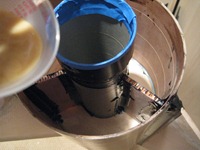
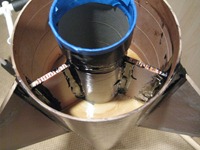
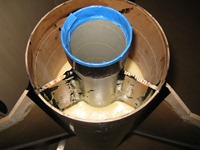
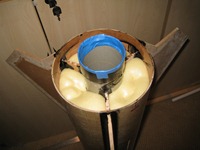
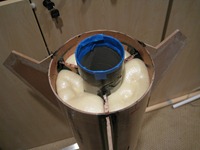
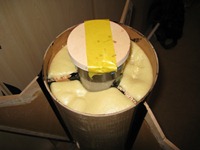
As you can see, it came out PEFECT. The foam finished expanding exactly where I had calculated, and started to harden at the end of the fintab, where the boat tail would glued later. This was almost too easy – something is going to go wrong down the road.
At this point, I start to pack everything up in my wife’s minivan to bring up to Bong Recreational Area in the morning to show my TAP sponsors my progress so far, and (I hoped) to launch a few rockets.
Oh yeah, since I had a little bit of the foam left on the spoon, I smeared it into a rocket on my bench that needed a pretty serious repair. Once the foam cures, I ‘ll just sand it down, and laminate a small piece of e-glass over the foam. Thiis stuff is great.
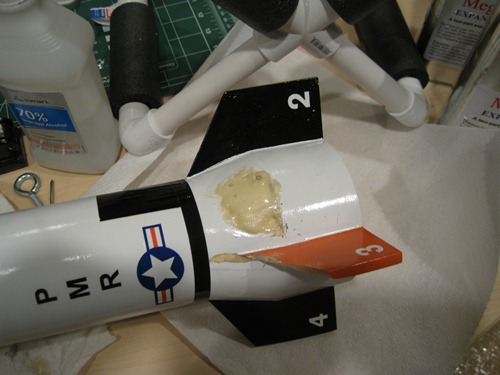
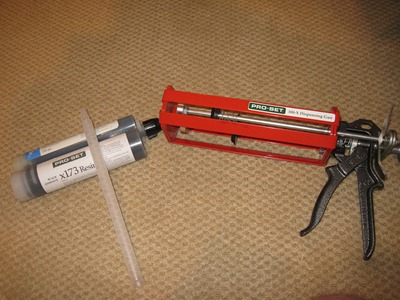
I have two questions. where did you buy your glues? I wasnt aware of either brand. The second question is about the fiberglassing of your booster. Are you going to document that? looks incredibly smooth.
Hi!
Sorry for the late reply, work has been tough the last few days.
I buy the Hysol from McMaster-Carr, part # 6430A24
The pro-set is a little harder to come by.
I bought my first set from the rocket retailer Hawk Mountain (https://hawkmountain.ws/secure/components.asp?groupid=113). That was a LONG time ago. Their website is till up, but has a copyright of 2000 on it. I don’t know if they are still around.
CST has it: http://www.cstsales.com/pro-set_epoxy.html I’ve also bought some Carbon Fiber from them, but they are a little pricey. I don’t think they carry the aerospace, or cartridge versions.
I bought these x173 in cartridge format from Aerospace Composites, which dumped pro-set for pro-lam, which I haven’t tried yet.
Hope this helps.